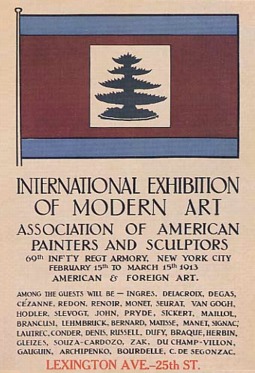

The following works were among those exhibited in the Armory Show of 1913:

Pierre Puvis de Chavannes (French, 1824-1898),
Beheading
of St. John the Baptist (La Décollation de St. Jean Baptiste),
1869, oil on canvas,
about 48 x 64 inches, Barber Institute of Fine Arts, Birmingham,
England. See Symbolism.
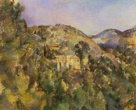
Paul Cézanne (French, 1839-1906),
View
of the Domain Saint-Joseph (La Colline des pauvres),
c. 1877, oil on canvas,
25 5/8 x 32 inches, Metropolitan Museum of Art, NY. The Metropolitan
Museum of Art purchased this painting from the Parisian art dealer
Ambroise Vollard during the Armory Show. See Post-Impressionism.

Odilon Redon (French, 1840-1916), Roger
and Angelica, c. 1910, pastel
on paper, 36 1/2 x 28 3/4 inches,
Museum of Modern Art, NY. See Symbolism.

Vincent van Gogh (Dutch, 1853-1890), Olive Orchard, oil
on canvas, 28 5/8 x 36
1/4 inches (72.7 x 92.1 cm), Metropolitan Museum of Art, NY.
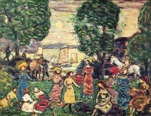
Maurice Brazil Prendergast (American, born
Newfoundland, 1859-1924), Crepuscule, c. 1912, oil
on canvas, 20 1/2 x 28
inches, private collection. See the Eight.

Edvard Munch (Norwegian, 1863-1944), Madonna, 1895-1902, lithograph and woodcut, complete: 23 3/4 x 17 1/2 inches
(60.5 x 44.5 cm), edition: c. 250, Museum of Modern Art, NY.
This was exhibited in the influential Armory
Show of 1913. See Expressionism,
madonna,
and Symbolism.
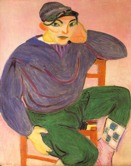
Henri Matisse (French, 1869-1954), The Young Sailor, II (Jeune Marin), 1906,
oil on canvas,
39 3/8 x 31 7/8 inches, Gelman collection, Mexico City. See Fauvism.
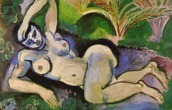
Henri Matisse, The Blue Nude (Souvenir de Biskra), 1907,
oil, 36 1/4 x 55 1/8 inches, Baltimore Museum of Art, MD.

Henri Matisse, The Red Madras Headress (Mme Matisse: Madras
Rouge), summer 1907, oil
on canvas, 39 1/8 x 31
3/4 inches (99.4 x 80.5 cm), Barnes Foundation, Merion, PA.
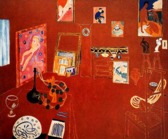
Henri Matisse, Red Studio (Panneau rouge), 1911, oil on canvas,
71 1/4 x 86 1/4 inches, Museum of Modern Art, NY.

Henri Matisse, Nasturtiums with the Painting "Dance II",
1912, oil on canvas,
75 1/2 x 45 3/8 inches (191.8 x 115.3 cm), Metropolitan Museum
of Art, NY. See dance.
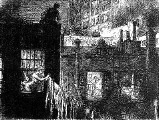
John Sloan (American , 1871-1951), Night
Windows, 1910, etching,
5 1/4 x 7 inches. See the
Eight.
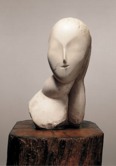
Constantin Brancusi (French, born Romania,
1876-1957), The Muse, 1912, marble, 17 3/4 x 9 x
6 3/4 inches, Solomon R. Guggenheim Museum, NY.
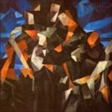
Francis Picabia (French, 1879-1953), The Procession, Seville (La Procession, Seville),
1912, oil on canvas,
48 x 48 inches, private collection. This painting was exhibited
in the Armory Show of 1913.
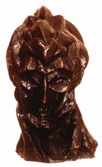
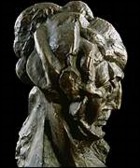
Pablo Picasso (born Pablo Ruiz-Picasso) (Spanish,
1881-1973), Head of a Woman (Fernande Olivier), 1909,
bronze, height
16 1/4 inches. This was Picasso's first attempt to create three-dimensionally what he
had developed two-dimensionally
with cubism.
As H. H. Arnason said, although it is therefore "historically
of the greatest significance as the first step toward an entirely
new kind of sculpture -- that
of construction or assemblage — at this point
Picasso had not yet realized the implications of cubism for sculpture."

![]()
Wassily Kandinsky (Russian, 1886-1944), Improvisation
No. 27 (Garden of Love), 1912, oil
on canvas, 47 3/8 x 55
1/4 inches, Metropolitan Museum of Art, NY.
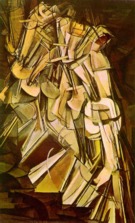
Marcel Duchamp (French, 1887-1968), Nude
Descending a Staircase, 1911-1912, oil
on canvas, 58 x 35 inches,
Philadelphia Museum of Art, PA — the most controversial work
in the Armory Show. It is an example of what is called Cubo-Futurism
because it shows the influences of both Cubism and Futurism. See Dada.
Also see abstraction, The Eight, Intimisme, salon, and The Ten.
https://inform.quest/_art
Copyright © 1996-![]()